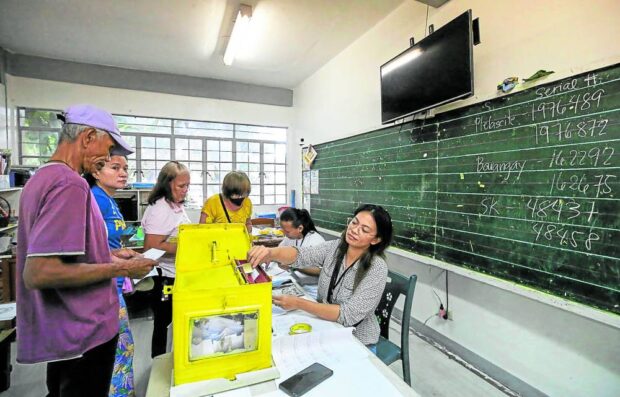
PRIORITY GROUP | Elderly voters and those with disabilities submit their ballots at a polling precinct in San Jose del Monte Heights Elementary School in the City of San Jose del Monte, Bulacan, during the village and youth polls on Monday, Oct. 30, 2023. They also cast their votes to affirm or reject the conversion of San Jose del Monte into a highly urbanized city. (Photo by LYN RILLON / Philippine Daily Inquirer)
CITY OF MALOLOS, Bulacan, Philippines — Voters in Bulacan province junked the bid to convert the component city of San Jose del Monte into a highly urbanized city (HUC) in a plebiscite held alongside Monday’s Barangay and Sangguniang Kabataan elections.
According to the certificate of canvass released by the Commission on Elections (Comelec) early Wednesday, the “no” votes prevailed in 19 towns and three component cities in the province by a margin of nearly 200,000 votes. Only the City of Meycauayan and the town of Marilao supported the conversion.
Voters in San Jose del Monte also rejected the move to make their city independent from Bulacan after the “no” votes (97,954) edged out the “yes” votes (92,714), for a margin of 5,240 votes.
Comelec said a total of 820,385 voters thumbed down San Jose del Monte’s ascension to HUC status through Proclamation No. 1057 issued on Dec. 4, 2020, by former President Rodrigo Duterte. The bid, however, was supported by 620,707 voters.
The proclamation requires Bulacan to ratify the conversion, which has been rejected by the “One Bulacan” movement led by Gov. Daniel Fernando. He is supported by Vice Gov. Alex Castro, 18 provincial board members, 450 of Bulacan’s 572 barangay captains, and one of 24 Bulacan mayors.
Of the 2.09 million registered voters in Bulacan, 1,608,004 cast their ballots on Monday’s plebiscite, reflecting a 76.85-percent turnout, Comelec said.
CAMPAIGN PUSH Posters supporting the conversion of San Jose del Monte City into a highly urbanized city (HUC) are hung in a covered court across San Jose del Monte Heights Elementary School on Monday. Bulacan voters rejected the city’s HUC bid during a plebiscite held with the Barangay and Sangguniang Kabataan elections. —LYN RILLON
READ: Cops nab 38 over liquor ban violation in Bulacan and Pampanga towns
READ: DPWH opens 7.64-km stretch of Arterial Road Bypass Project in Bulacan
‘Economically dislocated’
Opponents of the conversion, like San Jose del Monte Councilor Romeo Agapito, argued that 70 percent of the 651,813 residents of the city were “ordinary workers” in the nearby towns of Bulacan and Metro Manila and that “they could not afford the high taxes to be collected when the city becomes an HUC.”
According to Agapito, they feared that San Jose del Monte would also be “economically dislocated” from Bulacan when New Manila International Airport in Bulakan town opens in a few years.
“We are thankful to God, and to all [San Jose del Monte residents] and the whole people of Bulacan for not allowing us to be separated from our mother Bulacan province,” the councilor told the Inquirer in a text message on Wednesday. “We are really not yet ready to become a fully independent city.”
In a previous interview, Fernando said he was “saddened” to know that one of the cities of Bulacan had wanted to separate from the province.
“There is no father who will be happy if one of his children drifts away. This is painful to me. I always pray for one and united Bulacan,” the governor said.
But Fernando stressed the importance of “democracy,” adding that Bulacan residents should decide on the city’s fate.
Former Governors Wilhelmino Sy-Alvarado and Roberto Pagdanganan also openly campaigned to oppose the conversion, saying they wanted to keep Bulacan “intact and united as one.”
Opponents of the city’s HUC bid also expressed apprehension over its impact on scholarship grants provided by the provincial government to students in the city and job opportunities for fresh graduates.
Qualified
San Jose del Monte fully meets the requirements of an HUC since its population is already three times higher than the 200,000 minimum based on the Local Government Code of 1991.
Advocating for the city’s change of status, San Jose del Monte Mayor Arthur Robes and lone district Rep. Florida Robes said the city needed to operate as a fully independent city to serve its huge population.
The city’s residents make up 17.5 percent of Bulacan’s 3,708,890 population, although the local population grew after the national government began relocating Metro Manila’s informal settlers to Barangay Sapang Palay in 1968.
At least 75 percent of the city’s current population are resettled households, according to local officials.
Data also showed that the city had a net income of P141 million last year, which was way above the P50-million annual income needed for its HUC bid.